A paper presented at the 13th annual colloquium of the Board Game Studies Association, Paris, 2010
Most traditional games seem more or less abstract, but most publishers won't look at new abstracts because they're hard to market. That's because it's hard to get wholesalers and retailers to accept games when the first thing they're going to ask is "What's it all about?". Replies such as "Nothing", or "Itself", are not regarded as strong selling points.
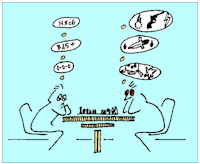
Abstract or representational? It's all in the mind...
Abstract games do have a following, but mainly among hardcore as opposed to casual gamers. The scripting language "Zillions of Games" appeared in 1998 and is still going strong. The International Abstract Games Organisation (IAGO) was formed in 2006 to raise to promote their appearance of abstracts in games tournaments. In 2000 a Canadian quarterly magazine called Abstract Games started up, but unfortunately collapsed after 16 issues.
These followers tend to restrict their definition of abstract games to those that are:
- entirely strategic, with no random elements;
- based on perfect information throughout; and
- for two players only, as any abstract for more than two is said to introduce a distracting element of "politics" (stronger players ganging up on weaker ones).
In short, they
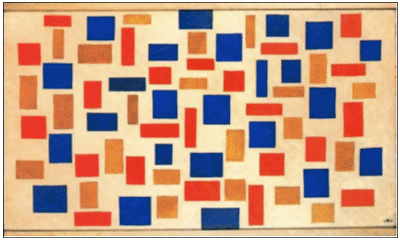
Theo van Doesburg: Composition XI, 1918.
I want to play a game on it!
are more interested in strategy than in abstraction as such. However, the two properties are not synonymous.
For example, games like Diplomacy are strategic without being abstract, while Backgammon and Ludo are abstract without being
strategic.
Personally I like abstract games for the same reason I like abstract art: not because they are strategic because they
are beautiful.
In fact, my taste for abstract art may well be rooted in my childhood liking for abstract games. I vividly recall
one Christmas, when I was about eight or nine, visiting a cousin who had been received the present of a games compendium: a very
neat box with all the usual traditional abstracts cleverly packed inside it. One of the components was a set of dominoes with
coloured spots. I had only ever seen white spots on dominoes before, and to see them now in different colours struck me as
incredibly beautiful and desirable. Ever since then the word "game" conjures up abstract patterns of colours, numbers, and
elemental shapes, and I can rarely see an abstract painting without wanting to play a game on it.
In considering the interplay between abstraction and representationalism I will refer to a three-layer or "sandwich" model of
a game:
1. The topmost layer is what it represents, its associations, symbolism, external references, etc - in other words,
"what it's all about".
2. The middle layer is that of its physical components.
3. The bottom layer is the play of the game: its mechanisms, rules and procedures.
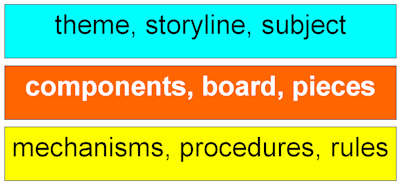
A sandwich model
This bottom layer is the essentially abstract element of a game. All games must have one, whether or not they have an uppermost
thematic or representational layer. To this extent all games can be perceived as fundamentally abstract, just as any painting can
be perceived as an abstract arrangement of line, shape and colour without regard to its nominal subject. You could define an
abstract game as one whose uppermost layer is transparent, like a watch with a transparent face.
This fact is not always obvious. An urge to "meaning" is very powerful in the human psyche and it is hard to think of a game so abstract that it does not attract external associations. For example, Draughts and Chess immediately suggest stylised battles between armies; Backgammon and Snakes & Ladders are naturally classed as "race" games. But the opposite perception, that of the abstract nature of a thematic game, is more subtle. For example, I believe that the success of Monopoly was not due primarily to its theme but to the fact that it introduced entirely new mechanisms of play, especially that of owning the spaces you land on and charging others for landing on them. Many casual gamers might have thought game great because of its theme, whereas what really attracted them was the novelty of its mechanism, even though they were unaware of its novelty. One might say that all great games are great because they are the first of their procedural type.
Traditional games are abstract because they predate the days of printing and mass production. The ancients had to make do with boards consisting of diagrams drawn by hand in the sand or scratched into stone - which is why they consist of squares, circles and triangles but not hexagons - and pieces consisting of shells or pebbles or dried animal droppings. Their abstraction is often underlined by their names or titles (ludonyms?), which refer to nothing outside themselves. Thus, in various languages, Draughts means "moves", Mancala means "to move, transfer", Senet means "to go past", Backgammon means the "going-back" game, Go and Merels both mean stones or gaming pieces. We perceive them as abstract simply because they do not literally depict recognisable objects.
But the fact that they were not literally representational does not mean that they were not thematic. Themes, or at least
titles, became attached to them through the natural human tendency to reify the abstract - to apply external reference to
significant but abstract objects. Thus the Greek game of Petteia, meaning pebbles, is matched by the later Roman game
of Latrunculi, meaning robbers. Pieces that move round a board become representative of horses, or dogs and jackals, or
fox and geese, wolf and sheep, goats and tigers, and so on.
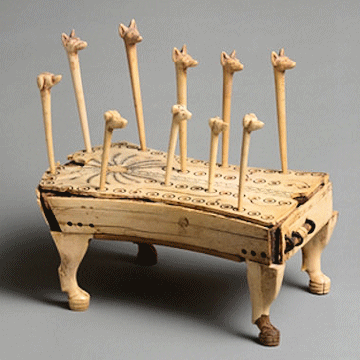
Dogs & Jackals
They are not literally representational but symbolically representative
of the animals concerned - though rare exceptions exist, such as the ancient Egyptian game that we call dogs and jackals.
In A History of Board Games Other than Chess, Murray writes "I will adopt a classification based on the view that games are typical of the early activities and occupations of man - the battle, the siege or hunt, the race, alignment, arrangement, and counting". Note that he says only that they are "typical of", not that they purposefully represent. He does not assume that games were consciously devised as representations of existing activities, but merely proposes conveniently descriptive terms based on obvious but post-hoc resemblances.
As time progresses the themes become more complex and detailed. It was only after a thousand or more years that Senet became associated not with the way pieces went past each other but with the theme of passing from this world to the next, and meaningful significance attached to the last five squares of the board.
Some time before the 6th century CE the ancestor of Chess appeared in India under the name Chaturanga. Chaturanga literally means "four-limbed", and was the term applied to the classical Indian army of infantry, cavalry, elephantry, chariotry. This is a more elaborate game to produce because it requires six immediately recognisable types of gaming piece. But were these pieces and their distinctive moves invented with the deliberate intention of simulating the activities of the Indian army? I doubt it. True, Murray himself wrote: "The game of chess was invented when some Hindu devised a game of war, and, finding the ashtapada board convenient for his purpose, adopted it as his field of battle." But he surely never intended his metaphorical expression to be taken literally, and conspicuously avoided repeating it in his later Short History of Chess. So we won't insult his memory by imagining him to believe that the game was invented as a representation of warfare. Do we really believe that someone said "You know the four-limbed army? Well, how about turning it into a board game?', and someone else replied "Brilliant! Let's make the chariots move orthogonally, because they don't turn corners very well, and give the horses a sort of prancing move…" and so on? Was Chaturanga invented as a representation of war, or was the martial theme attached to a pre-existing abstract game or mathematical puzzle? A theory espoused by certain Russian researchers is based on the observation that the moves of the various Chess pieces can be executed in a regular order or 'tour' in such a way as to yield the same total, turning the board into an 8x8 magic square.
It is with the introduction of paper and rudimentary forms of printing that games become more overtly representational, producing for example the Chinese game of Mandarin Promotion, the Japanese E-sugoroku (pictorial sugoroku), the Indian forerunners of Snakes & Ladders, and, in Europe, the Renaissance Game of Goose. Many representational games require image replication on a scale not achievable before the invention of paper and printing. They become increasingly pictorial with 19th-century technical advances in printing, and more elaborate in recent decades with advances in reprography and electronic image generation. My 1973 prototype of Hare & Tortoise was hand-drawn on thin card; nowadays no self-respecting games inventor would dare to offer anything less than the final product. It seems somehow ironic that the rise of photography and reprography has enabled painting to become more abstract but board games to become more representational.
Attaching a theme to a basically abstract game may be described as the "bottom-up" process of games invention. It contrasts with the "top-down" method more prevalent today, that of starting with a theme or storyline and working down to the underlying mechanisms. But the traditional "bottom-up" approach is still valid, provided that the theme is dictated by the mechanism and not merely stuck on to it afterwards like sugar-coating to a bitter pill. I should like, if I may, to offer my own game of Hare & Tortoise as an example.
In the beginning there were no animals. There was only an empty track of 64 squares folded in upon itself on an 8x8 squared board, and three basic rules of play:
- You can move as far as you like provided that you can pay for it in units of energy;
- You acquire fresh units of energy dictated by different functions on different squares; and
- The number of units you thereby gain varies in inverse proportion to your position in the race.
Hence, given a standard four-player game, it was obvious that some of the squares would be numbered 1, 2, 3 or 4. There would be four other functions: a moving backwards square, a chance or hazard square, an emergency supply square, and a square equivalent to Monopoly's "Free Parking". I had no thought of what these squares would be called and merely differentiated them with abstract symbols. I then made dummy runs in which I played the parts of four different players, of whom one would get ahead fast but quickly run out of steam, another would spend only one unit at a time but lag behind all the others, a third would alternate between the two strategies, and the fourth would play at random. It was only during the second or third experiment that the phrase "hare & tortoise" suddenly sprang to mind. It then became obvious that two of the four symbols should be hares and tortoises, and that the units of energy would be carrots and lettuces, thus replacing the remaining two symbols. And of course the hare squares must be hazards, because hares are traditionally considered mad an unpredictable.
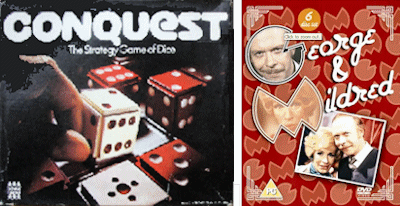
Conquest, alias George & Mildred
They are not literally representational but symbolically representative
of the animals concerned - though rare exceptions exist, such as the ancient Egyptian game that we call dogs and jackals.
I hope you will consider this a valid example of attaching to an abstract game a theme that is not merely in keeping with th
underlying abstract mechanism but ineluctably determined by it. But the bottom-up process lends itself to considerable abuse. A
striking example is that of Geoffrey Hayes's excellent dice-rolling game strategy game Conquest (Duell,
in Germany). In the 1970's it appeared in England under the title "The George versus Mildred Dice Game", referring to a domestic
television sitcom of the period (19). A similar but less drastic thing happened to an abstract three-player game of mine
which the publishers named Shoulder to Shoulder after a television series about suffragettes. Fortunately, the phrase itself
is timeless and reasonably descriptive of the theme.
Modern board games designed for the mass market illustrate a reversal of this pattern from bottom-up to top-down.
Games inventors, especially amateurs, mostly start with a theme and by a process of abstraction work down to its
mechanisms. The laziest approach is simply to adapt an existing mechanism, which explains why there are so many spin-offs
of existing games made by simply changing the subject matter. (It has been said that most 19th and 20th-century popular
board games are variations on the Royal Game of Goose.) Ideally one would allow the chosen theme to suggest a mechanism that
is original because it is inspired by the theme. This would explain the appeal of the original Landlord's Game and the
success of its descendant Monopoly. Just as Goose was the first
western game to proceed from an abstract race track to a pictorial one, and to introduce bits of external reality in the form of
geese, wishing wells, inns, bridges and so on, so Monopoly was the first significant western game to turn the linear race track
into a closed loop enabling endless circuits, and, more significantly, to introduce the revolutionary concept of owning spaces on
the board and charging other players for landing on them.
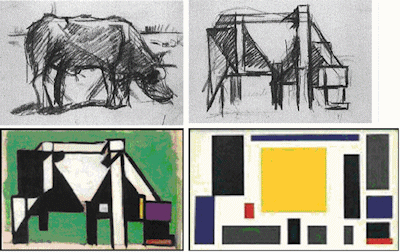
The fourth cow (series of transformations by Theo van Doesburg)
Turning any real-life experience or phenomenon into a game necessarily involves a process of abstraction, similar to the process illustrated by Theo van Doesburg's series of images of a cow progressing from literal to almost unrecognizably abstract. I think it unlikely that any game as abstract as the fourth cow in this series would actually have been produced from a real-life original as literal as the first. Probably the third is about as far as a game can go without losing reference to its thematic origin. Any game as abstract as the fourth cow would have been invented purely as an abstract, and if its inventor then wished to give it a theme to make it more palatable he probably wouldn't have arrived at a cow - he might as easily have turned it into a two-dimensional version of Monopoly, or a visit to a supermarket.
Given that a non-abstract game is representational, what sort of things do games represent? It has been said that the mass market requires themes that relate to the current mythology, which is most strongly embodied in film, television and popular magazines. With this in mind I thought it would be interesting to analyse a random selection of 250 modern games to see how many of them were thematic as opposed to abstract, and whether any generalisations could be made about the choice of theme. This number is made up as follows:
- 100 selected at random from the 2010 edition of Dagmar de Cassaen's Spielehandbuch;
- The contents of the book 100 Best Family Games recently published in America;
- The 40 winners of the German Spiel des Jahres from 1979 to 2008; and
- The top 10 games as chosen by the American magazine Games, in their latest list of 100 best games.
Initial results were surprising:

In summary, 27% abstract (more or less), 63% thematic (fantasy or realist), 10% verbal.
First, despite what is often claimed by publishers, purely abstract games account for about one fifth of the total, and the addition of semi-abstracts brings it to more than a quarter. By "semi-abstract" I mean a game that obviously started out as an abstract in the inventor's mind but subsequently had a theme added to it for the sake of pictorial if not thematic interest. Second, between a fifth and a quarter of thematic games were based on fantasy, or the world of the imagination, rather than on aspects everyday reality like running a bus company. I find this interesting, because the very fact that fantasy games are divorced from reality puts them to some extent on a par with purely abstract games. After all, the squares, circles and other geometric and topological objects that form the playing material of abstract games are merely Platonic ideals: they have no more "real" existence than the witches, wizards and unicorns of fantasy.
If you classify abstract and fantasy games together as "non-realist" then these account for about 41% of the total, and if you count the 10% of word and quiz games as non-thematic, then thematic games based on "real life" account for barely 50% of all modern published games. I must say I should have expected that proportion to be higher.
Of real-life thematic games, the commonest themes were as follows:
| Theme | Example(s) | total | % |
|---|---|---|---|
| Animals | Zooloretto, etc | 10 | 4 |
| Building construction | Alhambra, etc | 10 | 4 |
| Dominion building | Civilisation, Settlers of Catan, etc | 10 | 4 |
| War | Risk, Axis & Allies, etc | 10 | 4 |
| Medieval | Carcassonne, etc | 10 | 4 |
| Travel & transport | 10 Days in the USA, etc | 8 | 3 |
| Deduction, detection | Clue[do], Sleuth, etc | 6 | 2 |
| Trading | Monopoly, etc | 6 | 2 |
| Art, antiques, archaeology | Adel Verpflichtet, etc | 6 | 2 |
| Business | Power Struggle/Machtspiele, etc | 5 | 2 |
| Space | Adastra, etc | 5 | 2 |
| Historical | Guillotine, etc | 5 | 2 |
| Railways | Age of Steam/Dampfross, etc | 4 | 2 |
| Ancient history | Arena, etc | 4 | 2 |
| Sport | BasketBoss, etc | 3 | 1 |
| Exploration | Tikal, Keltis, etc | 3 | 1 |
| Medical | Pandemic, Omega Virus, etc | 3 | 1 |
Of course, these figures are not precise, as some games represent thematic overlaps. For example, Alhambra is medieval building, Settlers of Catan is fantasy dominion-building, Tulipmania is a business game based on the 17th-century Dutch tulip trade, Omega Virus is medical science fiction in space, and so on.
Something needs to be said about word, quiz, and "trivia" games. Do they count as abstract or thematic, or are they an entirely separate division? I suggest that they can be either. For example, a trivia game about cinema is obviously thematic because cinema is "what it's all about", whereas a word game like Scrabble is abstract in that the meanings of the words involved is totally irrelevant - they have no reference to anything outside the game itself. A person who doesn't speak a word of English could, in theory, simply learn a list of the only letter combinations that one is allowed to make in the game.
Talking of word games reminds me of something I wrote in my Oxford History of Board Games, namely:
A point of interest about modern board games is their gradual shift of emphasis away from the board and into the circle of players. Traditional board games like Chess and Draughts are essentially positional. It is obvious from a diagram of the final position exactly who has won, and why. In a game like Monopoly, on the other hand, a great deal of gaming material doe not come into contact with the board. The board is still essential to the play, but the winning is measured in terms of the other material. Wandering further away from the board, we reach a game like Trivial Pursuit and its derivatives, in which all the real play takes place off the board. The board is almost an irrelevance: it does little more than keep a score, like a Cribbage board.
Finally, we reach fantasy games, some of which involve a board as a convenience for keeping track of inter-player relationships, but most of which are boardless role-playing games, overlapping with 'play' in its theatrical rather than any other sense of the word.
To generalise, we might say that whereas earlier board games were thematic or representational in a visual or pictorial sense, over the past century they have become more suffused with personal interaction and role-play, making them increasingly representational in a theatrical sense. Most Chess players think of themselves as playing an abstract game, not as playing the role of a general deploying an army in battle. Monopoly, on the other hand, positively invites you to play the part of a property dealer, and I dare say real-life property dealers have more of an edge when playing Monopoly than real-life generals have when playing Chess.
I will conclude by noting that when Johan Huizinga wrote, in Homo Ludens, that "play is either a contest for something or a representation of something" he forgot to mention the fact that it is often both. He could also have mentioned that representation can take many different forms, from allusive to referential to pictorial to dramatic.
1. After I delivered this talk Niek Neuwahl pointed out that a third way of originating new games is to design, or even find, a piece of interesting equipment with gaming potential and devise a game to go with it. How true! I'd guess that that's how all games began - by playing with natural objects already in existence, like nuts or knucklebones.
2. It is interesting, if not necessarily of any great practical value, to introduce terms of gradation between purely abstract and highly representational games. For example:
- Purely abstract: Backgammon, Go, Reversi.
- Titular: abstract but bearing a suggestive title, such as Latrunculi as opposed to Petteia, Othello as opposed to Reversi.
- Allusive, referential, decorative: abstract but with an arbitrary theme or storyline applied post hoc for the sake of amusement or palatability (Hyena, Goose, Snakes & Ladders)
- Thematic: As above, but with a theme highly or uniquely appropriate to its mechanism (Cluedo [Clue], Hare & Tortoise, Carcassonne).
- Representational: Monopoly, Diplomacy
- Simulative: Highly realistic role-playing games designed primarily for education and training.




